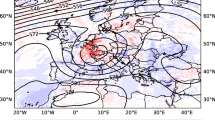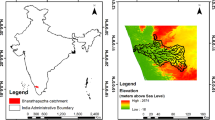Abstract
Stochastic weather generators are statistical models widely used to produce climate time series with similar statistical properties to observed data. They are also used as downscaling tools to generate climate change scenarios for impact studies. Precipitation is one of the main variables simulated by weather generators and is also a key variable for impact studies, especially for hydrology. Precipitation is usually simulated by multiple precipitation models which have been proposed for simulating site-specific precipitation. However, these models’ performance in simulating watershed-averaged extreme precipitation, especially in representing hydrological extremes, has not been well-investigated. Accordingly, this study compares the performance of six probability distributions (exponential, gamma, skewed normal, mixed exponential, hybrid exponential/Pareto, and Weibull distributions) and a polynomial curve-fitting method in generating precipitation for simulating hydrological extremes over three basins using a set of extreme indices. The results show that except for the exponential distribution (EXP), all of the methods produce the distribution of observed precipitation at the daily, monthly and annual scales reasonably well for all three river basins. Although the three-parameter hybrid exponential/Pareto distribution (EXPP) overestimates precipitation extremes, other three-parameter models produce extremes accurately. The three-parameter mixed exponential (MEXP) distribution outperforms other models for simulating precipitation extremes. However, with respect to representing hydrological extremes, the MEXP distribution is not the best model. When simulating extreme streamflows with synthetic weather data, the EXP distribution shows the worst performance, while the curve fitting method (PN) performs the best. The inferiority of the EXPP distribution in generating extreme precipitation does not propagate to extreme flow simulations. Meanwhile, the performance of WEB is moderate in terms of representing hydrological extremes. Overall, finding the model that best reproduces precipitation for simulating hydrological extremes is not as clear-cut, since the performance of each model is extreme-indices dependent. Taking all of the indices into account, the MEXP and the PN appear to be superior in representing extreme precipitation and hydrological extremes.






Similar content being viewed by others
References
Acharya N, Frei A, Chen J, Decristofaro L, Owens EM (2017) Evaluating stochastic precipitation generators for climate change impact studies of New York City’s primary water supply. J Hydrometeorol 18:879–896
Baffault C, Nearing MA, Nicks AD (1996) Impact of CLIGEN parameters on WEPP-predicted average annual soil loss. Trans ASAE 39:447–457
Chen J, Brissette FP (2014a) Comparison of five stochastic weather generators in simulating daily precipitation and temperature for the loess plateau of china. Int J Climatol 34(10):3089–3105
Chen J, Brissette FP (2014b) Stochastic generation of daily precipitation amounts: review and evaluation of different models. Clim Res 59(3):189–206
Chen J, Brissette FP, Leconte R (2010) A daily stochastic weather generator for preserving low-frequency of climate variability. J Hydrol 388(3):480–490
Chen J, Brissette FP, Leconte R (2011) Uncertainty of downscaling method in quantifying the impact of climate change on hydrology. J Hydrol (Amsterdam) 401(3–4):190–202
Chen J, Brissette FP, Leconte R (2012) WeaGETS—a matlab-based daily scale weather generator for generating precipitation and temperature. Proc Environ Sci 13:2222–2235
Chen J, Brissette FP, Zielinski PA (2015) Constraining frequency distributions with the probable maximum precipitation for the stochastic generation of realistic extreme events. J Extreme Events 2(2):1550009
Chen J, Chen H, Guo S (2017) Multi-site precipitation downscaling using a stochastic weather generator. Clim Dyn 50(22):1–18
Dibike YB, Coulibaly P (2005) Hydrologic impact of climate change in the Saguenay watershed: comparison of downscaling methods and hydrologic models. J Hydrol 307(1–4):163
Duan QY, Gupta VK, Sorooshian S (1993) Shuffled complex evolution approach for effective and efficient global minimization. J Optim Theor Appl 76(3):501–521
French MN, Krajewski WF, Cuykendall RR (1992) Rainfall forecasting in space and time using a neural network. J Hydrol 137(1–4):1–31
Furrer EM, Katz RW (2008) Improving the simulation of extreme precipitation events by stochastic weather generators. Water Resour Res 44(44):317–322
Haan CT, Allen DM, Street JO (1976) A Markov chain model of daily rainfall. Water Resour Res 2(3):443–449
Hargreaves GH, Samani ZA (1985) Reference crop evapotranspiration from temperature. Appl Eng Agric 1(2):96–99
Harmel RD, Richardson CW, King KW (2000) Hydrologic response of a small watershed model to generated precipitation. Trans Asae 43(43):1483–1488
Jamaludin S, Jemain AA (2007) Fitting daily rainfall amount in peninsular malaysia using several types of exponential distributions. J Appl Sci Res 3(10):1027–1036
Khalili M, Brissette F, Leconte R (2011) Effectiveness of multi-site weather generator for hydrological modeling 1. Jawra J Am Water Resour Assoc 47(2):303–314
Li HX, Zhang YQ, Chiew FHS, Xu SG (2009) Predicting runoff in ungauged catchments by using xinanjiang model with modis leaf area index. J Hydrol 370(1):155–162
Li C, Singh VP, Mishra AK (2012) Simulation of the entire range of daily precipitation using a hybrid probability distribution. Water Resour Res 48(3):W3521
Li C, Singh VP, Mishra AK (2013a) A bivariate mixed distribution with a heavy-tailed component and its application to single-site daily rainfall simulation. Water Resour Res 49(2):767–789
Li Z, Brissette F, Chen J (2013b) Finding the most appropriate precipitation probability distribution for stochastic weather generation and hydrological modelling in nordic watersheds. Hydrol Process 27(25):3718–3729
Li Z, Brissette F, Chen J (2014) Assessing the applicability of six precipitation probability distribution models on the loess plateau of china. Int J Climatol 34(2):462–471
Liu Y, Zhang WC, Shao YH, Zhang KX (2011) A comparison of four precipitation distribution models used in daily stochastic models. Adv Atmos Sci 28(4):809–820
Lü H, Hou T, Horton R, Zhu Y, Chen X, Jia YW, Wang W, Fu XL (2013) The streamflow estimation using the xinanjiang rainfall runoff model and dual state-parameter estimation method. J Hydrol 480(4):102–114
Meyer C (2011) General description of the CLIGEN model and its history. USDA-ARS National Soil Erosion Laboratory, West Lafayette
Minville M, Brissette F, Leconte R (2008) Uncertainty of the impact of climate change on the hydrology of a nordic watershed. J Hydrol (Amsterdam) 358(1–2):70–83
Richardson CW (1981) Stochastic simulation of daily precipitation, temperature, and solar radiation. Water Resour Res 17:182–190
Safeeq M, Fares A (2011) Accuracy evaluation of climgen weather generator and daily to hourly disaggregation methods in tropical conditions. Theor Appl Climatol 106(3–4):321–341
Semenov M, Brooks R (1999) Spatial interpolation of the Lars-wg stochastic weather generator in great Britain. J Jpn Soc Bus Ethics Stud 11(2):205–216
Shi P, Chen C, Srinivasan R, Zhang XS, Cai T, Fang XQ, Qu SM, Chen X, Li QF (2011) Evaluating the swat model for hydrological modeling in the xixian watershed and a comparison with the xaj model. Water Resour Manage 25(10):2595–2612
Todorovic P, Woolhiser DA (1975) A stochastic model of n-day precipitation. J Appl Meteorol 14(1):17–24
Venugopal V, Foufoula-Georgiou E, Sapozhnikov V (1999) A space-time downscaling model for rainfall. J Geophys Res Atmos 104(D16):19705–19721
Vu TM, Mishra AK, Konapala G, Liu D (2018) Evaluation of multiple stochastic rainfall generators in diverse climatic regions. Stoch Environ Res Risk Assess 32(5):1337–1353
Wan H, Zhang X, Barrow E (2005) Stochastic modelling of daily precipitation for canada. Atmosphere 43(1):23–32
Wilks DS (1989) Conditioning stochastic daily precipitation models on total monthly precipitation. Water Resour Res 25:1429–1439
Wilks DS (1999) Interannual variability and extreme-value characteristics of several stochastic daily precipitation models. Agric For Meteorol 93(3):153–169
Wilks DS (2008) High-resolution spatial interpolation of weather generator parameters using local weighted regressions. Agric For Meteorol 148(1):111–120
Woolhiser DA, Roldán J (1982) Stochastic daily precipitation models: 2. A comparison of distributions of amounts. Water Resour Res 18(5):1461–1468
Zhang XC, Liu WZ (2005) Simulating potential response of hydrology, soil erosion, and crop productivity to climate change in Changwu tableland region on the loess plateau of china. Agric For Meteorol 131(3–4):142
Zhao RJ (1992) The xinanjiang model applied in china. J Hydrol 135(1–4):371–381
Acknowledgements
This work was partially supported by the National Natural Science Foundation of China (Grant No. 51779176, 51539009), the Overseas Expertise Introduction Project for Discipline Innovation (111 Project) funded by the Ministry of Education and State Administration of Foreign Experts Affairs P.R. China (Grant No. B18037), and the Thousand Youth Talents Plan from the Organization Department of the CCP Central Committee (Wuhan University, China). The authors are grateful to the China Meteorological Data Sharing Service System and the Department of Water Resources of Hunan Province for providing meteorological and hydrological data.
Author information
Authors and Affiliations
Corresponding author
Additional information
Publisher's Note
Springer Nature remains neutral with regard to jurisdictional claims in published maps and institutional affiliations.
Electronic supplementary material
Below is the link to the electronic supplementary material.
Rights and permissions
About this article
Cite this article
Zhu, B., Chen, J. & Chen, H. Performance of multiple probability distributions in generating daily precipitation for the simulation of hydrological extremes. Stoch Environ Res Risk Assess 33, 1581–1592 (2019). https://doi.org/10.1007/s00477-019-01720-z
Published:
Issue Date:
DOI: https://doi.org/10.1007/s00477-019-01720-z




